 |

|
|

|
|
|
 |

home
about
features
A-Z
books

|

|

Protz:
features
reviews
tastings
|

| |
Willard Clarke tries his hand at brewing
by Willard Clarke, 06/07
It was a classic case of putting my money where my mouth is. I've been writing about beer for 30 years and it was time to bend my back and make some of the stuff in order to look brewers in the face.
When an invitation to learn the brewing skills arrived from Everard's brewery, I was on the first train to Leicester. Everards, a family-owned company founded in 1849, has an estate of 161 pubs and is passionate about cask beer with such brands as Tiger, Beacon and Original.
But the company knows that pubgoers will stay loyal to cask beer only if they are assured of a
|
|
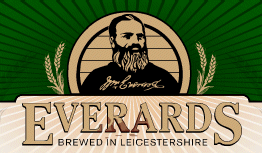
|
quality pint at the bar. With this in mind, Everards has built a training department at the brewery known as the Academy where it has developed cellar- training courses for its pub tenants.
The courses focus on cellar skills and cleanliness but a Gold Course takes on an added dimension by allowing selected publicans to design their own beers and brew them at Everard's celebrated brewpub, the Brunswick Inn in Derby. The beers that result from the courses can be sold in the tenants' pubs and are available throughout the brewery's estate.
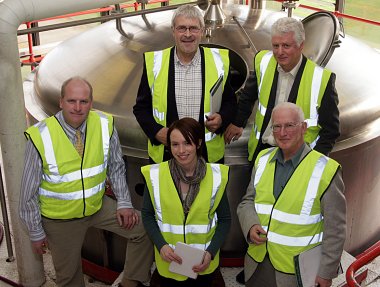
|
|
I was joined in the Everard's Academy by Sally Toms, editor of Beers of the World magazine, Dave Watson, a journalist from the Leicester Mercury, and Mick Hall, tenant of the New Inn in Enderby. Mick had been on a course before and was brought in as a "safe pair of hands".
The first afternoon was spent with Mark Tetlow, Everard's quality assurance manager, and head brewer Graham Giblet. They took us through the essential raw materials that make good beer.
|
The water in Leicester, as in nearby Burton-on-Trent, is rich in sulphates such as gypsum and magnesium, that give the classic pale ales of the East Midlands their dry, sulphury and astringent character.
Everards uses Maris Otter, the finest malting barley. Mark and Graham explained the germination and kilning processes that turn barley into malt with a high level of enzymes that can transform starch into fermentable sugar.
Hops add both aroma and bitterness to beer. Everards uses a wide variety, including such traditional English ones as Challenger, Fuggles and Goldings, the new "hedgerow" types such as First Gold that grow to only half the height of conventional plants, along with Willamette from the United States, Saaz from the Czech Republic and Styrian Goldings from Slovenia.
We had a sniffing session and found Goldings to be spicy, Saaz piny and Willamette resinous. Finally we studied and tasted some of Everard's house yeast. Mark and Graham told us there is five times more yeast at the end of fermentation than at the start, which is why there is always a plentiful supply and why so much is donated to Marmite in Burton. Yeast retains aromas, flavours and bitterness from one brew and passes them on to successive generations.
|
|
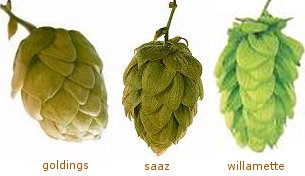
|
Graham took us on a detailed tour of his impressively modern brewhouse to see mashing and boiling taking place, followed by a view of the fermentation cellars.
Then it was back to the classroom to design our beer. My passion for the India Pale Ales brewed in Burton in the 19th century allowed me to convince my colleagues we should attempt to make an IPA. With advice from Mark and Graham on what could be achieved on the kit at the Brunswick, we settled on an ABV of 5.5 per cent, a colour rating of 14 � extremely pale � and 40 units of bitterness, which means hoppy and pungent. Mark suggested we add to Maris Otter pale malt a small amount of aromatic malt for a touch of colour and fruitiness. This is similar to "stewed" malt such as crystal, used solely for flavour and colour.
We chose English Goldings and Styrian Goldings as our main hops for aroma and bitterness. The finished beer would be dry hopped in cask with American Cascades.
The day's work done, we repaired to a few Everard's houses to savour the result of Graham's endeavours and also to choose a name for our beer. My suggestions of HPA (Hacks' Pale Ale) or SoS (Street of Shame) were vetoed in favour of the prosaic First Edition. Then it was off to bed for an early night, as we had to be up betimes to start brewing at 8am in Derby the following morning.
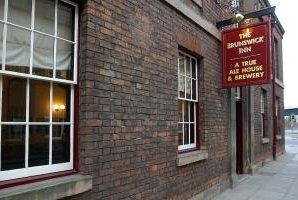
|
|
The Brunswick Inn is a small Victorian masterpiece, a wedge-shaped, redbrick pub at the end of a row of former railway workers' cottages a hundred yards from Derby station. A 10-barrel brewery was added
in the late 1980s and Everards bought the enterprise in 2002, with Graham Yates installed as both manager and brewer. Unlike the spacious brewhouse in Leicester, with computers to hand, the Brunswick is a tiny, cramped and decidedly hands-on brewery, not
designed to fit in Graham, his assistant
|
James Salmon, plus the four from the Academy. Our work began above the brewhouse, in a small room where we emptied sacks of pale and aromatic malt into a mill that ground it to the required consistency needed for the first stage of brewing, the mash. The mill is positioned above the mash tun below.
Back in the brewhouse we had to heat the water for the mash. It's astonishing how much water is used in brewing: seven pints of water to make one pint of beer. I was there to brew but I seemed to spend most of the day attaching hoses to valves and pumps in order to move water around the place.
The heated water was pumped to the mash tun when it had reached the desired temperature of 71 to 72 degrees C. We opened a valve above the tun and the crushed grain, known as grist, poured into the vessel. A delightful aroma of biscuits and Ovaltine filled the small room. Now we had to stir with great vigour to thoroughly mix grain and hot water -- or "liquor" in brewer-speak.
The mash tun is on a platform and clambering up is not easy. As the porridge in the tun became thicker, stirring, with a giant paddle, became harder. By 10.45 James was satisfied with the consistency of the mash and called a halt to stirring. We left the mash for an hour to its own devices, with enzymes converting starch to sugar.
More water! We pumped it from the liquor tank to another tank on the floor above to prepare for the "sparge". After an hour we opened the slotted base of the mash tun and ran the sugary extract in to an open tank or "back" with a filter in the middle: the filter held the spent grain while the tank filled up with rich-smelling liquid now known as wort. We tasted some and it was hot, delicious and revivifying.
James fitted a revolving, slotted arms to the roof of the tun and we had to pump yet more hot water to sprinkle or sparge the remaining grain to wash out any lingering sugars. Finally the wort was pumped to the copper where we added sacks of Goldings and Styrian hops. James encouraged us to "throw them in!" but being good journos we responded: "Surely you mean drizzle them?"
The hops were added in batches, at the start of the boil, after 25 minutes and then at the end, for additional aroma, after around 1� hours. Then the delicious piny, herbal and resinous hopped wort was pumped to the collecting vessel, the spent hops were filtered out, and then the liquid was pumped through a paraflow to cool and then run into the fermenting vessel, where the temperature was 20.8 degrees.
Our final act of the day was clamber up a step ladder and add, from a plastic bucket, a slug of the Brunswick yeast. We left it to its mysterious devices to turn sweet and hopped wort into beer.
I slept well on the train home. The boring but essential tasks of digging out the mash tun and the copper had taken their toll of a sedentary body.
Ten days later a small, 4�-gallon cask of beer arrived at CAMRA head office. I tapped and vented it, left it overnight then assembled some anxious looking volunteers to taste my beer.
It was a pale bronze colour and had a spicy and citrus fruit aroma balanced by biscuity malt and hop resins. It was exceptionally dry in the mouth and the finish, but tart fruit and juicy malt offset the dryness. Spices, citrus and bitter hops held up well in the finish.
The final alcohol rating was 5.43 and the colour was 13.8. The only disappointment was that the units of bitterness were 33.2, way off the 40 aimed for. A phone call to Mark Tetlow elicited the information that the Brunswick kit was not best suited for full hop extraction.
But the assembled tasters found it a highly quaffable pint, full of malt, hop and fruit flavours. Not, perhaps, a true IPA but a Damned Good Beer.
|
|
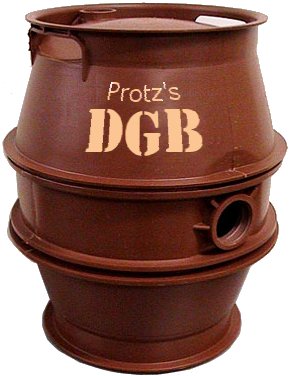
|
Never mind First Edition. For me, this will always be Protz's DGB.
|
|
home
about
features
A-Z
books
|

